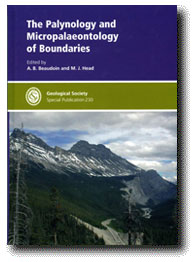The Palynology
and Micropalaeontology of Boundaries
Edited by
Alwynne Beaudoin and Martin Head
Geological
Society Special Publication 230, (2004) 355 pages
ISBN
1-86239-160-2. List Price:
£85.00

The Palynology
and Micropalaeontology of Boundaries
|
 |
This volume does what it says in the title: The papers collected by editors Alwynne Beaudoin and Martin Head, from a conference session at the 2002 Geological Association of Canada–Mineralogical Association of Canada symposium, focus on the micropalaeontology and palynology of boundaries. In this case, the 16 papers cover geological boundaries from or within the Cambrian-Ordovician, Ordovician-Silurian, upper Permian, Upper Carboniferous, Jurassic, Jurassic-Cretaceous, Cretaceous, Cretaceous–Tertiary, Palaeocene–Eocene, Eocene–Oligocene, and Oligocene–Miocene. The papers also span a wide range of fossil groups from conodonts through to pollen.
My initial thought when asked to review this volume was, “what an odd title for a book”. In many ways, palaeontologists are always looking at boundaries of one kind or another. Usually these are stratigraphic horizons because “things happen”. Palaeontologists study boundaries because we are conditioned, like all geoscientists, to find positive results that will look exciting and attract funding. Hence, the prospect of finding extinction, compositional turnover, taxonomic diversity changes and biotic recovery at a well-chosen boundary is attractive research fodder. By contrast, the study of what happens in the intervals between boundaries is a somewhat polemic niche market for research. Perhaps my reaction stemmed from instantly associating a boundary with a time line. It also stemmed from an instant, unwelcome anticipation that brought forth mental images of copious range-charts and photographic plates that would stress distribution pattern over process. In this regard, I found one of the most interesting contributions from the editors themselves in their introductory chapter. Beaudoin and Head discuss the concept of boundaries – and correctly point out that they are not limited to separating major geological time periods but can include many different aspects. Factors that influence altitudinal controls on tree growth, the latitudinal gradient in species richness, and differences between communities with increasing bathymetry for example also deserve consideration in a boundary context.
Essentially, this raises issues on continuous versus discrete variability and the controls on such parameters. Instead of just collecting fossils across a boundary, this chapter also made me think about whether we can make boundaries by the way we collect and interpret fossil data. After this promising beginning, it was disappointing that many of the following chapters were restricted to the description and analysis of biotic change across major temporal boundaries. As individual papers, many are fine within the confines of their focus and are certainly worth reading if you are interested in what happens across certain boundaries to certain groups of organisms. Some contributions, such as that from Nikenko and Mickey, also offer valuable new data from regions such as the Russian arctic that are otherwise inaccessible to Anglophone scientists. Many papers also offer broader implications on regional climate or environmental change. But a few papers do stand out. The first contribution offered by Zhang and Barnes considers statistically the spatial and temporal distribution of Cambrian-Ordovician conodonts from western Newfoundland. A discussion on how the Red Queen hypothesis fits with turnover exhibited by planktonic foraminifera from the Middle Cretaceous – present (Doran et al.) will have wider appeal. The contribution by Norman MacLeod may also provoke some debate. He offers a statistical approach, through Monte Carlo permutations, on identifying those factors that are associated significantly with mass extinction. Results indicate that major eustastic sea level changes and continental flood basalt events are important. The article covers much more ground than this and is worth a read even if you are a big fan of bolides. Perhaps one theme that unites these chapters, if they are considered in aggregate, is that the definition of a boundary is critical for evaluating its palaeobiological significance. But this is hardly a new insight. In summary though, this volume is worth a browse if you are interested in taxonomic turnover across certain geological boundaries.